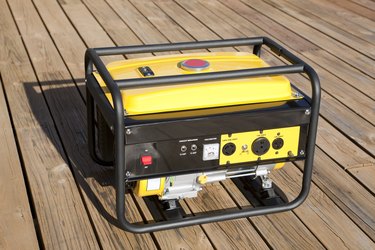
The NEMA L14-30 twist lock receptacle is the type you usually find on portable generators that provide 240-volt electricity. The plug is rated by the National Electrical Manufacturer Association to supply 240-volt electricity at a maximum current of 30 amps. It goes without saying that you need a matching NEMA L14-30 twist lock plug on the end of any cord you want to plug into a generator with one of these receptacles. Although the configuration of the plug looks complicated from the outside, it actually has the same four terminals you would find on any 240-volt plug. Two are for hot connections, one is for neutral, and one is for ground. Because the plug-receptacle combination is designed to handle a 30-amp current, you need to hook it up it with 10-gauge or heavier wire.
The Procedure for Wiring a NEMA L14-30 Plug
Video of the Day
The cable to which you attach a 30-amp twist lock plug has to be a minimum of 10 AWG, which is one size larger than standard 120-volt residential cable. You need three conductors plus a ground. Two of the conductors, which are red and black, are hot wires, and one – the white one – is neutral. The ground wire, which may be bare or coated with green insulation, is required but it isn't considered a conductor. All 240-volt, 30-amp appliance cords conform to these specifications.
Video of the Day
Because the 10-gauge wire is a little beefier than 120-volt cable, it's more difficult to twist around terminal screws. To get around this, it's a good idea to crimp a brass ring to each of the wires. If you do this, you'll be able to remove each terminal screw in the plug housing, insert it through the ring and tighten the screw back into the terminal. This makes the connections safer and more secure.
To wire a NEMA L14-30, do the following:
- Unscrew the housing screws on the plug and separate the housing to expose the terminals. You'll see two brass screws, a chrome one and a green one. The two hot wires go on the brass terminals, but it doesn't matter to which of these terminals you attach either the red or black wire. The white wire goes on the chrome terminal and the ground wire goes on the green one.
- Insert the end of the cable through the opening in the plug housing, strip an inch of insulation off the end of each wire, crimp on a connection ring, and make the connections using a screwdriver.
- When you're done, reassemble the housing and tighten the wire clamp to hold the cable securely.
Where Can You Use a 30-amp Twist Lock Receptacle?
Although the NEMA L14-30 receptacle is commonly found on generators, that's not the only place you'll find them. It's an appropriate receptacle to use for powering any 240-volt appliance in your house that draws a maximum of 30 amps of electricity like:
- air conditioners
- low-capacity electric water heaters,
- some types of power tools
Other plugs with straight prongs will also work, but the advantage of a 30-amp twist lock plug is that you can't accidentally separate it by knocking into it and you can't accidentally pull out the cord. That's especially important in areas with a lot of traffic, such as workshops.
Installing a 30-Amp Twist Lock Receptacle
The procedure for wiring a NEMA L14-30 receptacle is similar to the one for wiring a plug. The 10-gauge, 3-conductor cable must be connected to a 240-volt, 30-amp breaker in the main panel. Receptacles are stationary and designed to handle 10-gauge wire, so you usually don't need to crimp connection rings onto the wires. The wiring sequence is the same: The hot wires go on the brass terminal, the neutral wire goes on the chrome one and the ground wire gets connected to the green ground terminal.